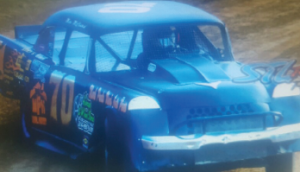When Marc McClintock first began experiencing back pain, he chalked it up to the rigors of his racing career. For more than 36 years, Mr. McClintock has built and raced stock cars, high-powered race vehicles that compete on short oval or circular dirt or paved tracks.
“I live in a commercial building, with my residence on the top floor and my racing shop on the bottom,” Mr. McClintock explains. “It’s not unusual for me to spend hours lying on the floor in my garage working on a transmission, and I thought that, combined with years of racing, might have led to my back pain.”

Marc McClintock
Despite the discomfort, Mr. McClintock continued building dirt cars and even started a new job in 2015 as a high-performance racing technology instructor at Ranken Technical College in St. Louis where he teaches students how to build engines and effectively work in a machine shop.
To combat his back pain, Mr. McClintock saw a chiropractor who offered him temporary pain relief. Despite regular chiropractic treatments, his soreness became so severe that Mr. McClintock found it impossible to perform daily activities.
“In the summer of 2016, I began experiencing excruciating pain in my back, knees, neck and arms,” Mr. McClintock says. “My wife, Tracy, had to help me put on my shoes and socks and even button my shirt.”
As his symptoms progressed, Mr. McClintock made an appointment with his family doctor. Even after performing a battery of tests, Mr. McClintock’s doctor was unable to pinpoint the cause of his unrelenting pain. Mr. McClintock remembers feeling helpless as his symptoms worsened.
“One day, I stood upright after sitting in my recliner, and the pain was so intense that it took my breath away,” Mr. McClintock says. “When my pain got to the point where I was unable to lift a fork to my mouth, I was sure that I would soon require round-the-clock care at a skilled nursing facility.”
The Diagnosis

One of Mr. McClintock’s race cars, with his grandkids, Josilyn and Jogan, in charge. He made this car from a Studebaker truck.
It wasn’t until he received a referral to Richard Brasington, MD, a rheumatologist at Washington University School of Medicine in St. Louis (and a past associate editor of The Rheumatologist), that Mr. McClintock was able to receive an accurate diagnosis.
“Dr. Brasington told me I had ankylosing spondylitis (AS), a degenerative autoimmune disease, also referred to as arthritis of the spine,” Mr. McClintock says. “I was told that although there is no cure for AS, it is manageable with injections of adalimumab.”
According to a study published in the January 2008 issue of Arthritis & Rheumatism, 0.6 million to 2.4 million adults have AS.1 The Spondylitis Association of America says that diagnosis delays are common, because the onset of the disease and symptoms can vary from person to person.2 Many patients present with low-grade fevers, joint pain and severe fatigue, but some like Mr. McClintock, experience only pain.
When a patient’s discomfort becomes severe enough to seek treatment, they often see a chiropractor, as Mr. McClintock did, or a sports medicine doctor who might not have AS on their radar. Because back pain is such a common medical problem, physical therapy (PT) is often the first course of action.
Mr. McClintock was actually prescribed PT by his doctor. Although the exercises helped with his stiffness, he says they did little to relieve his pain.
Fifty-eight at the time of his diagnosis, Mr. McClintock was also older than the typical AS patient. Symptoms typically present between the ages of 17 and 45, although they can occur in children, or later in life, such as with Mr. McClintock.
Lifelong Treatment

Another of Mr. McClintock’s race cars.
As the pain in his lower back and buttocks became worse, Mr. McClintock’s doctor referred him to Dr. Brasington, who took his medical history and gave him a physical examination, including X-rays. Mr. McClintock also had bloodwork done, including a test for HLA-B27. The presence of HLA-B27 is associated with certain autoimmune and immune-mediated diseases, including AS, which causes inflammation of the joints in a patient’s spine.
“No one else in my family had [previously been diagnosed with] AS, although my brother, who is 17 years older than I am, was diagnosed with polymyalgia rhuematica this year,” Mr. McClintock says.
After starting on adalimumab in January 2017 and receiving one injection every other week, Mr. McClintock began to see an immediate, noticeable improvement in his pain. “I was told I would probably be on [adalimumab] the rest of my life and that the injections would keep the disease from progressing, while also offering pain relief,” Mr. McClintock says.
Living Continues
As he began to feel better, Mr. McClintock resumed racing and has gone on to win races in five states. He continues to work at the university during the day and to work on cars in his home garage in the evening. He also focuses on staying healthy, getting an annual flu shot and a pneumonia vaccination. When he’s not racing, he enjoys spending time with his wife of 39 years, Tracy, his adult children, son Dustin and daughter Amber, and his seven grandchildren.
“At my worst, I wasn’t able to turn my head enough to drive safely, or even lift a pillow, so it felt good to have my pain under control and return to racing this year,” Mr. McClintock says. “I can’t lift as much weight as I used to, but I continue to feel better each day and am working to rebuild my strength.”
Mr. McClintock continues to see Dr. Brasington every six months, and he remembers a recent conversation the two had: “Dr. Brasington said I was the reason he came to work every day. I said he was the reason I could go to work every day.”
Linda Childers is a health writer located in the San Francisco Bay area.
References
- Helmick CG, Felson DT, Lawrence RC, et al. Estimates of the prevalence of arthritis and other rheumatic conditions in the United States. Part I. Arthritis Rheum. 2008 Jan;58(1):15–25.
- Spondylitis Association of America.


